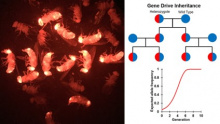Genetic manipulation of wild populations with different gene drive strategies

JaCKSON CHAMPER
School of Life Sciences, Peking University, Beijing, China
Link to webinar: https://umontpellier-fr.zoom.us/webinar/register/WN_UYdIsUyuSfuQmUAduigcuw
Summary
Gene drive alleles bias inheritance in their favor, allowing them to quickly spread throughout a population. They could combat vector-borne diseases by rapidly spreading a cargo gene that blocks pathogen transmission, or they could directly suppress vector populations or others such as invasive species. However, CRISPR gene drives frequently generate resistance alleles when DNA cleavage is repaired by end-joining instead of homology-directed repair, which can impede the spread of the drive. Suppression type homing drives in mosquitoes have potentially overcome this limitation, but computational modeling predicts that such drives may not succeed in spatially structured natural populations in which the “chasing” phenomenon can result in chaotic, long-term persistence of both drive and wild-type alleles. To overcome resistance allele formation in modification drives, we combined several methods, allowing a homing-type drive to rapidly reach all individuals in a cage study. Another successful drive uses a new “toxin-antidote” mechanism to spread. These toxin-antidote drives could allow modification or suppression to be confined to a specific target population.
Recent publications:
1 Champer J*, Kim IK*, Champer SE, Clark AG, Messer PW. Suppression gene drive in continuous space can result in unstable persistence of both drive and wild-type alleles. Mol Ecol, 30(4), 1086-1101, 2021.
2 Champer J*, Yang E*, Lee E, Liu J, Clark AG, Messer PW. A CRISPR homing gene drive targeting a haplolethal gene removes resistance alleles and successfully spreads through a cage population. Proc Natl Acad Sci US, 117(39), 24377-24383, 2020.
3 Champer J, Lee E, Yang E, Liu C, Clark AG, Messer PW. A toxin-antidote CRISPR gene drive system for regional population modification. Nat Com, 11(1), 1082, 2020.
Watch previous seminars on our YouTube channel: https://www.youtube.com/channel/UCrX4IsZ8WIFcDa0ZmC7rcQg
Contact: nicolas.rode@inrae.fr
Contact du Comité SEEM: seem@services.cnrs.fr. Contact du Labex CEMEB: cemeb-gestion@umontpellier.fr


